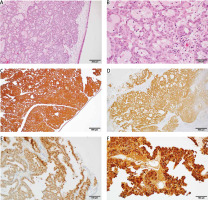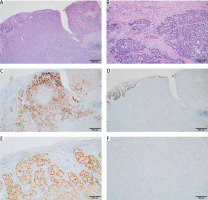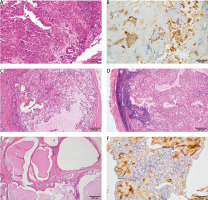Introduction
Secretory carcinoma (SC) of the salivary gland was first documented by Skálová et al. in 2010, distinguishing it from other epithelial tumours based on its distinct morphological, immunohistochemical (IHC), and molecular characteristics. The characterization of this novel entity was established through the analysis of 16 cases of tumours originating from major and minor salivary glands [1]. Secretory carcinoma predominantly manifests in the parotid gland, with subsequent occurrences observed in the oral mucosa and submandibular gland [2]. Although rare, SC cases in the sinonasal tract have also been reported [3, 4]. Microscopically, SC of the salivary gland exhibits similarities to mammary SC, displaying microcystic, tubular, follicular, or papillary-cystic structures with luminal secretions. The cells possess vesicular round or oval nuclei with low-grade atypia and minimal mitotic activity. Chromatin appears finely granular, and nucleoli are centrally located. Cellular cytoplasm appears granular or vacuolated [5]. Immunohistochemically, the cells express S100, SOX10, CK7, and mammaglobin, while showing negative staining for p63, p40, DOG1, and NR4A3 [6]. In approximately 90% of cases, SC presents a characteristic chromosomal translocation, t(12;15)(p13;q25), resulting in the formation of the ETV6-NTRK3 fusion gene. In a small subset of cases, other fusion genes involving ETV6 may arise, such as ETV6-RET, ETV6-MET, and ETV6-MAML3, or the VIM-RET fusion gene [7, 8].
Due to its specific morphological features, IHC profile, and molecular alterations, SC of the salivary gland was incorporated into the fourth edition of the World Health Organization’s classification of malignant tumours [9]. Substantial advancements have since been made in comprehending the clinical characteristics and prognosis of SC patients [10–13]. Clinically, SC is typically categorized as a low-grade malignancy. Lymph node metastases occur in around 25% of cases, while distant metastases are exceedingly rare [12]. The mortality rate associated with SC is low. Unfavourable prognostic factors include stage and high-grade transformation. Currently, no definitive predictive biomarkers have been identified for SC. However, the presence of the ETV6-NTRK3 translocation may serve as a significant predictive marker for targeted therapy using TRK inhibitors [7, 14].
The objective of this study was to conduct a single-centre retrospective clinicopathological analysis of patients diagnosed with SC of the salivary gland since 2017, coinciding with its inclusion in the World Health Organization (WHO) classification. The analysis encompassed the evaluation of biomarkers, including gene rearrangements utilizing fluorescence in situ hybridization and next-generation sequencing, as well as IHC assessment employing the pan-TRK antibody.
Material and methods
This study employed a retrospective cohort design, utilizing data obtained from patients diagnosed with SC of the head and neck at the Maria Sklodowska-Curie National Research Institute of Oncology in Warsaw, Poland, between 1 January 2017 and 31 December 2022. The collected data included crucial demographic information such as sex (male, female) and date of birth. Clinical details encompassed the date of diagnosis, age at diagnosis, tumour site, tumour staging (T1, T2, T3, T4), regional lymph node involvement (yes, no), presence of metastasis (yes, no), recurrence (yes, no), stage (I–IV), treatment modalities administered (surgery, radiotherapy, radio-chemotherapy), and the outcomes of additional tests like fluorescence in situ hybridization and next-generation sequencing (NGS). Moreover, to assess the relative prevalence of SC among all malignant cases of major salivary gland tumours, the number of diagnosed malignant tumours of major salivary glands within the same research institution during the specified period was analysed.
Haematoxylin and eosin- and IHC-stained slides, when available, were reviewed to confirm the pathomorphological diagnosis and the results of IHC tests (S100, DOG1, mammaglobin, CK7, p63, GATA3, and GCDFP-15). Immunohistochemical studies were conducted using commercially available reagents commonly used in routine pathological diagnostics. The pan-TRK antibody, clone EPR17341 (Roche Diagnostics), was employed for the IHC assessment of NTRK gene rearrangements.
Descriptive statistics were employed to summarize the demographic and clinical characteristics of the study population. For the variable of age at diagnosis, a histogram, Q-Q plot, and density plot were generated to assess the distribution. This analysis helped determine whether the distribution was normal or non-normal, guiding the decision to present the mean or median age. The mean and standard deviation were calculated to summarize the central tendency and dispersion of the age at diagnosis.
Results
A total of 6 patients were included in this study, consisting of 4 women and 2 men. The mean age at diagnosis was 50 years (range: 4–69 years) (Table 1, S1). The tumours were located in the parotid gland in 3 cases (Cases 1, 4, 6), the submandibular gland in Case 5, the sinonasal tract in Case 3 (Fig. 1), and the buccal mucosa in Case 2 (Fig. 2). Four cases of SC originating from major salivary glands accounted for 2.1% of all malignant tumours diagnosed in major salivary glands in our institution during the time of the study. Two patients with tumours outside the major salivary glands exhibited advanced tumour (pT4a) and disease (IV) stage. In Case 3, which had a sinonasal location, involvement of the frontal, maxillary, ethmoid, sphenoid sinuses, and nasal cavity on the left side was observed. Case 2 presented with a tumour measuring 71 mm with mucosal surface ulceration. In both cases, the tumours extended to the bone without causing destruction. Among patients with tumours located in major salivary glands, the primary tumours were classified as pT1 or pT2. Two patients experienced disease recurrence. Case 3 had a local recurrence 4 months after the surgery of the primary tumour. Case 6 exhibited a local recurrence within one year after the surgery, as well as 2 nodal recurrences at 10 and 25 years after the surgery of the primary tumour. No distant metastases were observed in any of the patients. All patients underwent surgical treatment, with 3 individuals additionally undergoing adjuvant radiotherapy or radio-chemotherapy (Case 6). Following recurrence of sinonasal carcinoma (Case 3), targeted therapy with TRK inhibitors was proposed, but the patient opted for repeat surgical treatment. As of 17 July 2023, all patients were alive and currently free from recurrence. The longest follow-up period was 30 years (for Case 6).
Table 1
Characteristics of the study group – patients diagnosed with secretory carcinoma of major and minor salivary glands, 2017–2022
Fig. 1
Case 3, secretory carcinoma of the sinonasal tract, 73-year-old male. Microcystic pattern with intact pseudostratified ciliated columnar epithelium covering the mucosa (HE 100×) (A), carcinoma cells exhibiting mild-grade nuclear atypia and pleomorphism (HE 400×) (B), immunohistochemistry (IHC) demonstrating positive staining for CK7 (40×) (C), IHC showing positive staining for S100 (40×) (D), IHC indicating positive nuclear staining for pan-TRK (200×) (E), IHC revealing positive staining for GCDFP-15 (200×) (F)

Fig. 2
Case 2, secretory carcinoma of the buccal mucosa, 59-year-old female. Tumour infiltrating the mucous membrane causing ulceration (HE 40×) (A), tumour base showing infiltrative growth pattern (HE 100×) (B), immunohistochemistry (IHC) demonstrating positive staining for mammaglobin (40×) (C), IHC showing negative staining for p63, with positive control in squamous cell epithelium (40×) (D), IHC indicating positive nuclear staining for pan-TRK (200×) (E), IHC revealing negative staining for DOG1 (200×) (F)

Secretory carcinoma was not initially diagnosed based on pathological examination in any of the 6 cases. In 5 cases, the initial diagnosis was made outside our centre, which serves as a reference centre, after surgical procedures, and the changes in pathological diagnosis were made after case consultation at our centre. In one case, the initial diagnosis made at our centre based on a small biopsy specimen was changed after the excision of the entire lesion. Initially, 2 patients were diagnosed with acinic cell carcinoma, 2 patients with mucoepidermoid carcinoma, and the remaining patients with low-grade sinonasal adenocarcinoma and myoepithelial carcinoma, respectively. In Case 6, the diagnosis changed multiple times. Initially, a pleomorphic adenoma was diagnosed in the primary tumour of the parotid gland, followed by mucoepidermoid carcinoma in the recurrence and 2 subsequent lymph node metastases. Finally, 25 years after the primary surgery, the correct diagnosis of SC was established through consultation of the specimens from the second episode of nodal recurrence in the neck (Fig. 3).
Fig. 3
Case 6, secretory carcinoma (SC) in a 4-year-old girl. Primary SC of the parotid gland initially diagnosed as pleomorphic adenoma (HE 20×) (A), immunohistochemical (IHC) showing positive staining for S100 in the primary carcinoma (100×) (B), first episode of lymph node metastasis in the neck (HE 100×) (C, D), second episode of lymph node metastasis in the neck (HE 40×) (E), IHC revealing negative staining for pan-TRK (100×) (F)

In terms of morphology, the tumour in 5 cases exhibited cells with granular or vacuolated cytoplasm, and the nuclei were vesicular, round, or oval in shape, showing low-grade nuclear atypia and rare mitoses. Only in Case 3, located in the sinonasal region, was high-grade nuclear atypia and increased mitotic activity (5/2 mm2) observed. The tumour cells formed microcystic, follicular, or papillary-cystic structures with luminal secretions. No necrosis or high-grade transformation was observed within the study group. A characteristic IHC profile was identified (Table 2). The tumour cells exhibited expression of S100, mammaglobin, and/or GCDFP15, as well as GATA3. DOG1 and p63 were not expressed, except in one case where focal p63 expression was detected. Strong nuclear expression of pan-TRK was observed in 4 cases during the IHC study (Figs. 1–3). Among the 5 patients who underwent molecular testing during routine diagnostics, ETV6 gene rearrangements were detected. Next-generation sequencing analysis identified 3 cases with the ETV6-NTRK3 fusion gene and in one case with the ETV6-RET fusion gene, coinciding with a negative pan-TRK IHC result in that patient (Case 5). In one case, a discrepancy was noted where the ETV6-NTRK3 gene fusion was detected, but the pan-TRK IHC result was falsely negative (Case 6).
Table 2
Immunohistochemical characteristics and molecular test results of study group – patients diagnosed with secretory carcinoma of major and minor salivary glands, 2017–2022
Discussion
Malignant tumours originating from salivary glands are considered rare cancers. According to data from the Polish National Cancer Registry, malignant tumours of major salivary glands account for approximately 0.2–0.3% of all malignant tumours [15]. In this study, we conducted a clinicopathological analysis focusing on SC, a specific type of salivary gland cancer. Within the analysed patient group, we identified 6 cases of SC, with 2 arising from minor salivary glands and 4 from major salivary glands. The latter group comprised 2.1% of all malignant tumours of major salivary glands diagnosed at our institution over a 6-year period (2017–2022). The cancers we investigated fall into the category of often misdiagnosed extraordinarily rare tumours and exhibit a high frequency of NTRK3 gene translocations [8, 16, 17]. Accurate diagnosis of SC is crucial due to its distinct clinical characteristics, prognosis, and the choice of optimal treatment, including tumour-agnostic therapy. The use of TRK inhibitors targeting the molecular alterations represented by NTRK1/2/3 gene rearrangements holds promise, regardless of the tumour type [7].
In the study group, the youngest patient at the time of diagnosis was 4 years old. However, it was only after 25 years, in 2017, that the correct diagnosis was established through consultation of subsequent recurrences and comparison of specimens from the primary surgery and 2 episodes of nodal recurrence. The diagnosis was ultimately confirmed by the detection of the ETV6-NTRK3 fusion gene using NGS analysis. To the best of our knowledge, this is the youngest patient reported with a diagnosis of SC and represents the longest follow-up period (30 years) documented in the literature [10, 12, 13, 18, 19]. Among children, mucoepidermoid carcinoma is the most commonly diagnosed malignant tumour of the salivary gland [20], while literature on the occurrence of SC is primarily limited to individual case reports [18]. In a comprehensive literature review comprising 119 original studies and a total of 642 patients with SC of the salivary gland, the youngest patient at diagnosis was 5 years old [10].
Secretory carcinoma predominantly develops in the parotid gland, occurring in approximately 75% of cases [10, 12]. In our study group, 3 out of 6 patients had parotid gland involvement, while 2 patients presented with rarer locations: the sinonasal tract and buccal mucosa [21–24]. The occurrence rate of SC in minor salivary glands is estimated to be around 20–23% [12, 13]. In a study by Baněčková et al. of 215 analysed SC cases, these less common locations accounted for 2.3% and 4.7% of the cases, respectively [12]. Our reported case of buccal mucosa SC demonstrated a locally advanced stage due to a larger tumour size (71 mm) compared to cases described in the literature [21, 24].
The prognosis for patients with SC is generally favourable, with disease-specific survival rates ranging from 95 to 98% and disease-free survival rates reported at 87% to 89% [12, 13]. Several negative prognostic factors have been identified, including a minor salivary gland origin, advanced pT stage, positive surgical margin, high-grade transformation, and necrosis. In our analysed group of 6 SC cases, all patients are currently alive; however, 2 patients experienced disease recurrence. In the case of sinonasal SC, local recurrence was observed 4 months after tumour resection. Unfavourable prognostic factors in this patient included a minor salivary gland origin, advanced pT stage, and positive surgical margin. Remarkably, another patient exhibited a distinctive pattern of recurrence, presenting with 2 nodal recurrences after intervals of 10 and 25 years of continuous surveillance. This delayed recurrence pattern, shown by such prolonged intervals, constitutes an intriguing and infrequent characteristic within the spectrum of SC. Nevertheless, given the current paucity of literature on the subject and the inclusion of SC in the WHO classification only in 2017, it is imperative to exercise patience, awaiting the accumulation of substantial comparative data before definitively ascertaining the rarity of this observation.
Despite the distinctive morphological characteristics and specific IHC profile consistently identified in the examined patient cohort [1, 25], cases of SC persistently confront diagnostic challenges. These challenges stem from both the rarity of the tumour and the limited exposure of diagnosticians to such cases [16]. Secretory carcinoma demonstrates a unique composition of monomorphic cells forming microcystic, tubular, follicular, or papillary-cystic structures accentuated by luminal secretions. These cells exhibit cytoplasmic granularity or vacuolation [5]. Immunohistochemically, the tumour showcases expression of S100, mammaglobin, CK7, and GATA3, while intriguingly lacking p63 and DOG1 expression [6]. Effective differentiation between SC and other salivary gland tumours, spanning the spectrum of benign to malignant, often hinges on astute selection of appropriate IHC staining panels harmonized with microscopic findings. Curiously, initial diagnoses within the scrutinized cohort encompassed acinic cell carcinoma, mucoepidermoid carcinoma, and pleomorphic adenoma, mirroring trends documented in the literature [1, 2, 14]. It is worth noting that acinic cell carcinoma diverges from SC due to the absence of S100 and mammaglobin expression, alongside its positive DOG1 expression. A significant caveat is the shared absence of p63 staining in both tumour types, alongside consistent SOX10 expression [12, 25]. In parallel, mucoepidermoid carcinoma, akin to SC and acinic cell carcinoma, exclusively consists of epithelial cells. Notably, the absence of S100 and SOX10 expression is a hallmark, while the presence of p63 expression specifically within epidermoid and intermediate cell types is a defining feature [6]. Moreover, the necessity to distinguish SC from the prevalent pleomorphic adenoma, the most encountered salivary tumour, emerges. The architecture of this tumour entails epithelial, myoepithelial, and chondromyxoid stromal cells. Remarkably, myoepithelial cells demonstrate a co-expression pattern of S100, SOX10, and p63 [1, 2]. A comprehensive differential diagnostic schema for SC, encompassing IHC analyses insights, is meticulously delineated in Table 3.
Table 3
Immunohistochemical differential diagnosis of secretory carcinoma
Accurate diagnosis of SC is crucial for treatment planning, particularly considering the potential candidacy of SC patients for TRK inhibitor therapy. Approximately 90% of SC cases exhibit NTRK3 gene rearrangements, leading to the formation of the ETV6-NTRK3 fusion gene [26]. Other fusion genes involving ETV6 are observed in the remaining cases [27, 28]. In our study, NGS analysis detected the ETV6-NTRK3 fusion gene in 3 out of 4 cases. Institutions equipped with molecular biology techniques can employ IHC pan-TRK as a screening method for detecting NTRK1/2/3 gene rearrangements [17]. Strong nuclear expression of pan-TRK is observed in SC cases with NTRK3 rearrangements, accompanied by weak cytoplasmic staining. Immunohistochemical pan-TRK demonstrates high sensitivity (91%) and specificity (close to 100%) in detecting SC of the salivary gland with ETV6-NTRK3 fusion [29, 30]. In our patient group, positive results for pan-TRK were found in 4 out of 6 cases. In one case, the negative pan-TRK result correlated with the NGS analysis, which detected the ETV6-RET fusion gene, while in the other case, it was a false negative result.
At present, there is no established standard treatment regimen for individuals with SC. Similarly to other salivary-type malignancies, the therapeutic approach primarily involves surgical intervention, often complemented by adjuvant radiotherapy or chemotherapy, particularly in cases with adverse prognostic factors, advanced disease grade, or metastatic involvement [31]. The consideration of TRK inhibitors as a therapeutic option in SC is particularly relevant for patients with distant metastases or unresectable lesions [32, 33]. In the analysed patient group, treatment consisted of surgical intervention, either alone or in conjunction with additional radiotherapy. Notably, in Case 3, who experienced rapid disease recurrence, targeted therapy was suggested, although the patient chose to undergo a subsequent surgical intervention.
Conclusions
Our study underscores the imperative of recognizing the potential for misdiagnosis in the context of SC of the salivary gland, a tumour that exhibits remarkable rarity and distribution across major and minor salivary glands, encompassing various age groups, including children. While SC typically carries a favourable prognosis, sustained vigilance is paramount due to the lurking potential for recurrence, even after extended periods. The intricate challenge of diagnosing SC persists, despite the presence of distinctive IHC profiles. Notably, the frequent occurrence of NTRK3 gene rearrangements highlights the potential utility of TRK inhibitors in a tumour-agnostic therapeutic approach, particularly pertinent for selection of patients.








